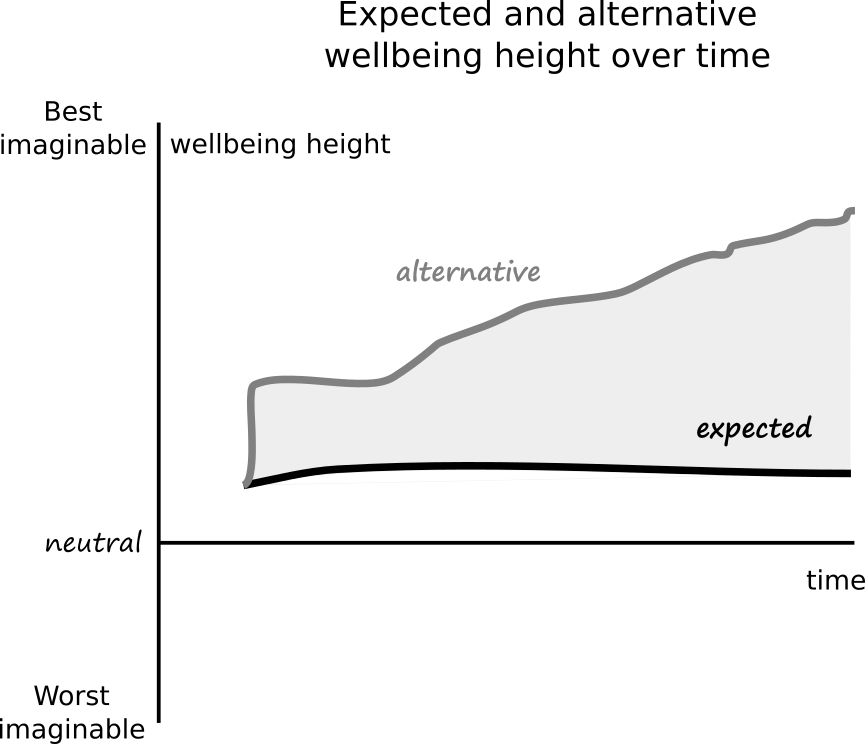Summary
I suggest that wellbeing height and depth data are gathered by two visual analog scales. Actual and alternative wellness height can be indicated on one scale. Wellness height and depth can be sketched over time. A weighted average of different respondents’ wellness depth indications can be used. Indications can be quantified by comparing indicator distances and scale lengths. I discuss methods to mitigate experimenter bias, control for scales non-linearity, address intra-group variance, and improve response accuracy.
Please let me know (comment below or send me a message) if you have informed estimates about the wellbeing height and depth of individuals who can be experiencing negative wellbeing height.
Wellbeing growth sequence
- Weighted wellbeing population theory
- Wellbeing height and depth visualizations
- Visual analog scale wellbeing data gathering method
Scales
2 survey VAS: wellbeing height and depth
A visual analog scale is a continuous line that extends from the lowest to the highest value of the metric which it quantifies.
This data gathering method surveys use two scales, one for an individual’s wellbeing height and another for their wellbeing depth. The wellbeing height scale includes the worst situation imaginable by that individual on one end and the best situation imaginable by that individual on the other end. The wellbeing depth scale shows zero depth on one end and maximum depth imaginable by that individual on the other end.
Momentary priorities and comparisons: actual and alternative height
The momentary actual and alternative wellbeing height scale can identify persons’ momentary priorities or compare respondents’ beliefs on the wellbeing impacts of different programs. To identify a priority, persons can be asked to indicate their current (actual) situation and that when their priority is resolved on the scale. The wellness impacts of different programs can be compared by asking respondents to label their situations when the projects’ hypothesized outcomes are in place.

Comparisons over time: expected and alternative height
To compare respondents’ estimates of wellbeing height impacts of different programs over a period of time, persons can be asked to graph their expected wellbeing and that with an intervention in place over time.
Respondents’ wellness height prediction bias can be estimated by comparing their prospective and retrospective indications of wellbeing height.

Wellbeing depth: relative to reference human, weighted average of responses
Persons can estimate the wellbeing depth of different individuals as well as themselves with different past or future experiences by labeling such on the wellness depth scale relative to that of the reference human (depth = 1).1 A weighted average of respondents’ (currently only possible for some species), empathizers’ (such as farmers and cohabitants), experts’ (including neuroscientists and psychologists), and other parties’ responses should be used in wellbeing estimates. The weighting methodology discussion is beyond the scope of this paper.
Similarly to wellness height, wellbeing depth can be also sketched over time.

Calculations
Wellbeing height
An individual’s momentary wellbeing height, hi, can be calculated as the fraction of length between neutral, n, and the indicator, i, of the length between neutral and best, b, for points above neutral, and as the negative of the fraction of the length between neutral and the indicator of the length between neutral and worst, w, for points below neutral.

An appropriate weighting function should be used for wellbeing height over time.
Scales of different individuals can be joined by relatively widely imaginable or known situations.
Wellbeing depth
Wellbeing depth is the individual’s wellness depth, di, (different estimates’ weighted average result) relative to that of the reference human, r, (depth = 1).

Discussion
Experimenter bias
Experimenter bias (responding in a way that negotiates or expresses a relationship with the enumerator) can be reduced by reviewer absence. For example, respondents can be asked to fill papers on their own and then place them in a box which will be shared with the researchers.
Scales non-linearity
The relative placement of various commonly known situations or consciousness states (such as the same individual half-awake) can assist with controlling for a respondent’s understanding of scales’ non-linearity.
Intra-group variance
The wellbeing height and depth can vary among individuals of the same group, such as species or location. Thus, relatively large random samples should be surveyed and distributions rather than means estimated by non-respondents. To gain further understanding of wellbeing determinants, individuals can be asked to rationalize their differing wellbeing height and depth levels.
Accuracy
Wellbeing height estimates can be most accurate for a human respondent’s recent past. In addition, persons may be able to relatively accurately evaluate their wellness height in situations in which others who the respondents can empathize with are. Also, humans may be able to estimate the wellness of animals of other species if they are in similar situations.
Respondents may be less able to indicate their wellness height in situations that the persons are less able to imagine (for example due to their limited emotional or rational references). In addition, relatively less empowered individuals whose wellbeing height is low or negative and constant or decreasing may be less willing to imagine alternatives, potentially due to their intent to shorten their wellness height scale and more heavily weight solidarity with those in similar situations than individual achievement. These issues can be addressed by showing respondents sincere humans in different alternative situations, asking persons to specify the reasons for their present wellbeing before asking about alternatives, and suggest that the research should inform solutions to problems which affect individuals in similar situations.
Welfare depth values can be most accurate for humans of similar backgrounds or of identities formerly held by the respondent. Estimating other species’ wellness depth can be challenging due to the limited emotional and rational references that enable such estimate. However, one may be able to approximate such by estimating their expected or experienced emotional activity in a situation experienced by another individual, considering that individual’s context and options.
Acknowledgements
I thank Jason Schukraft and Jojo Lee for useful comments on a draft of this post. I also thank Michael Plant and Geetanjali Basarkod for sharing background literature.
Ask: Wellness height and depth of negative wellbeing individuals estimates
Please let me know (comment below or send me a message) if you have informed estimates about the wellbeing height and depth of individuals who can be experiencing negative wellbeing height.

Footnotes
1 The consciousness equivalent of an awake sober relaxing human whose depth of wellbeing is 1.

Hello: I am a Brazilian physiatrist and we develop and study a new manual therapy approach. We need a tool able to measure the physical well being of the individuals in the short term, before and after a 20min manual maneuver, to be part of a research project aiming to the study the neurophysiology of such approach (using TMS and HRV). Do you believe your method could be used? If so, would it be possible that we chat about thar? Thanks a lot!
For sure! I think so and actually I am thinking more axes could be used - for example, one scale for 'relaxation' other for 'pain' other for 'energy' etc.